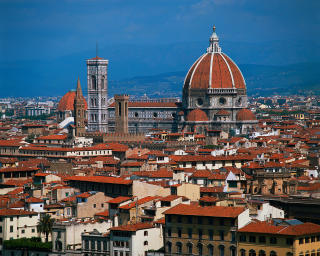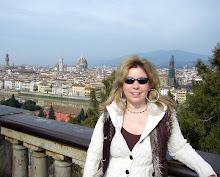 Today was a day for field trips for the business students. My International Business class visited the Museo di Storia della Scienze (Museum of the History of Science), which is a wonderful exhibit of scientific inventions, many by Galileo (I gave more detail in an earlier blog posting). Interestingly, this was the site of the first scientific institute in the world, which was founded in 1657 in memory of Galileo. Since my visit my first week, I have also learned that Galileo was sentenced to death in 1633 for publishing a defense of the Copernican theory of astronomy, which showed the sun, not the earth, as the center of the universe (blasphemous!). And here’s the really interesting part: although his life was spared, his death sentence wasn’t canceled until 1992! Yes, Pope John Paul II felt it was finally time to overturn this sentence, albeit more than 350 years later!
Today was a day for field trips for the business students. My International Business class visited the Museo di Storia della Scienze (Museum of the History of Science), which is a wonderful exhibit of scientific inventions, many by Galileo (I gave more detail in an earlier blog posting). Interestingly, this was the site of the first scientific institute in the world, which was founded in 1657 in memory of Galileo. Since my visit my first week, I have also learned that Galileo was sentenced to death in 1633 for publishing a defense of the Copernican theory of astronomy, which showed the sun, not the earth, as the center of the universe (blasphemous!). And here’s the really interesting part: although his life was spared, his death sentence wasn’t canceled until 1992! Yes, Pope John Paul II felt it was finally time to overturn this sentence, albeit more than 350 years later!Unfortunately, I wasn’t able to take photos in the museum, but I can tell you that the students had a great time and learned a lot about the extraordinary inventions that have reshaped our world and made the Industrial Revolution and global business possible. Here are the questions that students had to answer. How many would you get right?
______________________________________________________________________________
1. Which Medici started the Medicean collection of scientific instruments, and where did he house it? (Ground floor)
2. What instrument did Galileo improve and transform into the slide-rule, and what was this instrument used for? (1st floor, Salle I)
3. Describe Sir Morland’s invention. What is it and what does it do? How many silver discs are along its top? (1st floor, Salle II)
4. Look at the painting in Salle II; notice the instrument in his left hand. Now, find this instrument in Salle III. What is it called, and what is it made of? (1st floor, Salle II/III)
5. Whose finger is on exhibit in Salle IV? Which finger is it, and what is the irony of this? (Hint: you might want to ask a docent for more about this artifact.) (1st floor, Salle IV)
6. Look at Antonio Santucci’s great armillary sphere. What is at the center, and what does that represent? What do the seven spheres around the center represent (must be specific and name what each individual one represents)? (1st floor, Salle VII)
7. What major scientific advance, as shown on the various instruments in Salle X, has not yet been adopted by the U.S.? (Hint: Not adopting this resulted in the crash of a rocket ship on Mars.) (1st floor, Salle X)
8. What is the characteristic element of all mechanical clocks and music boxes, which completely changed the Industrial Revolution? Describe this device. (2nd floor, Salle XII)
9. What main surgical operations were performed in the late 1700s? Describe what the tool for amputations looks like. (2nd floor, Salle XVIII)
10. In the early years of pharmacy, the role of the pharmacist was most closely related to the role of what? Explain why. (2nd floor, Salle XIX)
Extra Credit
By what slang term were the bicycles of the 1800s frequently referred? (1st floor, special exhibit near exit)


No comments:
Post a Comment